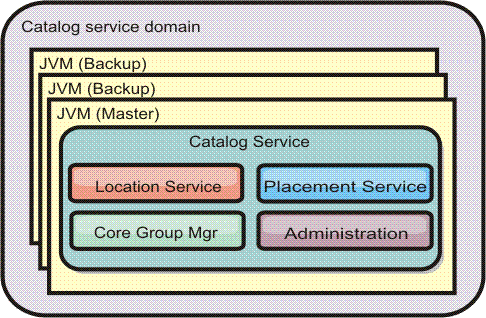Product overview > Cache > Caching architecture
Catalog service
The catalog service hosts logic that should be idle during a steady state and has little influence on scalability. The catalog service is built to service hundreds of containers becoming available simultaneously and runs services to manage the containers.

The catalog responsibilities consist of the following services:
- Location service
- The location service provides locality for clients that are looking for containers hosting applications and for containers that are looking to register hosted applications with the placement service. The location service runs in all of the grid members to scale out this function.
- Placement service
- The placement service is the central nervous system for the grid and is responsible for allocating individual shards to their host container. The placement service runs as a One of N elected service in the cluster. Because the One of N policy is used, there is always exactly one instance of the placement service running. If that instance should stop, another process takes over. All states of the catalog service are replicated across all servers hosting the catalog service for redundancy.
- Core group manager
- The core group manager manages peer grouping for health monitoring, organizes containers into small groups of servers, and automatically federates the groups of servers. When a container first contacts the catalog service, the container waits to be assigned to either a new or an existing group of several Java™ virtual machines (JVM). Each group of JVMs monitors the availability of each of its members through heartbeating. One of the group members relays availability information to the catalog service to allow for reacting to failures by reallocation and route forwarding.
- Administration
- The four stages of administering the WebSphere eXtreme Scale environment are planning, deploying, managing, and monitoring.
For availability, configure a catalog service domain. A catalog service domain consists of multiple JVMs, including a master JVM and a number of backup JVMs.
Figure 2. Catalog service domain

Parent topic:
Cache architecture: Maps, containers, clients, and catalogs
Related concepts
Maps
Container servers, partitions, and shards
Clients
Cache topology: In-memory and distributed caching
High-availability catalog service
Program for administrative tasks
Related tasks
Configure catalog and container servers